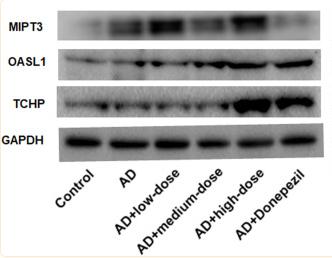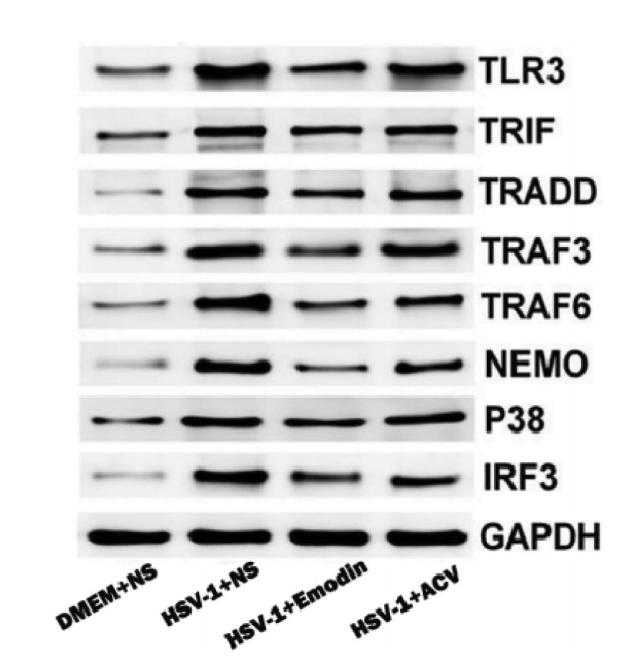| 产品: | TRAF3 抗体 |
| 货号: | AF5380 |
| 描述: | Rabbit polyclonal antibody to TRAF3 |
| 应用: | WB IF/ICC |
| 反应: | Human, Mouse, Rat |
| 预测: | Pig, Bovine, Horse, Sheep, Rabbit, Dog, Chicken, Xenopus |
| 分子量: | 68 kDa, 55 kDa; 64kD(Calculated). |
| 蛋白号: | Q13114 |
| RRID: | AB_2837865 |
产品描述
*The optimal dilutions should be determined by the end user.
*Tips:
WB: 适用于变性蛋白样本的免疫印迹检测. IHC: 适用于组织样本的石蜡(IHC-p)或冰冻(IHC-f)切片样本的免疫组化/荧光检测. IF/ICC: 适用于细胞样本的荧光检测. ELISA(peptide): 适用于抗原肽的ELISA检测.
引用格式: Affinity Biosciences Cat# AF5380, RRID:AB_2837865.
展开/折叠
CAP 1; CAP-1; CAP1; CD40 associated protein 1; CD40 binding protein; CD40 bp; CD40 receptor associated factor 1; CD40 receptor-associated factor 1; CD40-binding protein; CD40BP; CRAF 1; CRAF1; IIAE5; LAP 1; LAP1; LMP1 associated protein; LMP1-associated protein 1; MIPT3; TNF receptor associated factor 3; TNF receptor-associated factor 3; TRAF 3; Traf3; TRAF3_HUMAN;
抗原和靶标
- Q13114 TRAF3_HUMAN:
- Protein BLAST With
- NCBI/
- ExPASy/
- Uniprot
MESSKKMDSPGALQTNPPLKLHTDRSAGTPVFVPEQGGYKEKFVKTVEDKYKCEKCHLVLCSPKQTECGHRFCESCMAALLSSSSPKCTACQESIVKDKVFKDNCCKREILALQIYCRNESRGCAEQLMLGHLLVHLKNDCHFEELPCVRPDCKEKVLRKDLRDHVEKACKYREATCSHCKSQVPMIALQKHEDTDCPCVVVSCPHKCSVQTLLRSELSAHLSECVNAPSTCSFKRYGCVFQGTNQQIKAHEASSAVQHVNLLKEWSNSLEKKVSLLQNESVEKNKSIQSLHNQICSFEIEIERQKEMLRNNESKILHLQRVIDSQAEKLKELDKEIRPFRQNWEEADSMKSSVESLQNRVTELESVDKSAGQVARNTGLLESQLSRHDQMLSVHDIRLADMDLRFQVLETASYNGVLIWKIRDYKRRKQEAVMGKTLSLYSQPFYTGYFGYKMCARVYLNGDGMGKGTHLSLFFVIMRGEYDALLPWPFKQKVTLMLMDQGSSRRHLGDAFKPDPNSSSFKKPTGEMNIASGCPVFVAQTVLENGTYIKDDTIFIKVIVDTSDLPDP
种属预测
score>80的预测可信度较高,可尝试用于WB检测。*预测模型主要基于免疫原序列比对,结果仅作参考,不作为质保凭据。
High(score>80) Medium(80>score>50) Low(score<50) No confidence
翻译修饰 - Q13114 作为底物
| Site | PTM Type | Enzyme | Source |
|---|---|---|---|
| S9 | Phosphorylation | Uniprot | |
| T29 | Phosphorylation | Uniprot | |
| Y39 | Phosphorylation | Uniprot | |
| K138 | Methylation | Uniprot | |
| K168 | Ubiquitination | Uniprot | |
| S275 | Phosphorylation | Uniprot | |
| S281 | Phosphorylation | Uniprot | |
| K329 | Ubiquitination | Uniprot | |
| K335 | Ubiquitination | Uniprot | |
| S349 | Phosphorylation | Uniprot | |
| K351 | Ubiquitination | Uniprot | |
| S356 | Phosphorylation | Uniprot | |
| K369 | Ubiquitination | Uniprot | |
| K513 | Ubiquitination | Uniprot | |
| K557 | Ubiquitination | Uniprot |
研究背景
Regulates pathways leading to the activation of NF-kappa-B and MAP kinases, and plays a central role in the regulation of B-cell survival. Part of signaling pathways leading to the production of cytokines and interferon. Required for normal antibody isotype switching from IgM to IgG. Plays a role T-cell dependent immune responses. Plays a role in the regulation of antiviral responses. Is an essential constituent of several E3 ubiquitin-protein ligase complexes. May have E3 ubiquitin-protein ligase activity and promote 'Lys-63'-linked ubiquitination of target proteins. Inhibits activation of NF-kappa-B in response to LTBR stimulation. Inhibits TRAF2-mediated activation of NF-kappa-B. Down-regulates proteolytic processing of NFKB2, and thereby inhibits non-canonical activation of NF-kappa-B. Promotes ubiquitination and proteasomal degradation of MAP3K14.
Undergoes 'Lys-48'-linked polyubiquitination, leading to its proteasomal degradation in response to signaling by TNFSF13B, TLR4 or through CD40. 'Lys-48'-linked polyubiquitinated form is deubiquitinated by OTUD7B, preventing TRAF3 proteolysis and over-activation of non-canonical NF-kappa-B. Undergoes 'Lys-63'-linked ubiquitination during early stages of virus infection, and 'Lys-48'-linked ubiquitination during later stages. Undergoes both 'Lys-48'-linked and 'Lys-63'-linked ubiquitination in response to TLR3 and TLR4 signaling. Deubiquitinated by OTUB1, OTUB2 and OTUD5.
Cytoplasm. Endosome. Mitochondrion.
Note: Undergoes endocytosis together with TLR4 upon LPS signaling (By similarity). Associated with mitochondria in response to virus.
Homotrimer. Heterotrimer with TRAF2 and TRAF5. Interacts with LTBR/TNFRSF3, TNFRSF4, TNFRSF5/CD40, TNFRSF8/CD30, TNFRSF13C TNFRSF17/BCMA, TLR4 and EDAR. Interacts with MAP3K5, MAP3K14, TRAIP/TRIP, TDP2/TTRAP, TANK/ITRAF and TRAF3IP1. Interaction with TNFRSF5/CD40 is modulated by TANK/ITRAF, which competes for the same binding site. Interacts with TICAM1. Interacts with TRAFD1. Interacts with OTUB1, OTUB2 and OTUD5. Interacts with RNF216, MAVS, OPTN and TBK1. Identified in a complex with TRAF2, MAP3K14 and BIRC3. Interacts with BIRC2 and BIRC3. Upon exposure to bacterial lipopolysaccharide (LPS), recruited to a transient complex containing TLR4, TRAF3, TRAF6, IKBKG, MAP3K7, MYD88, TICAM1, BIRC2, BIRC3 and UBE2N (By similarity). Interacts with Epstein-Barr virus protein LMP1. Interacts (via RING-type zinc finger domain) with SRC. Interacts with CARD14. Interacts (via MATH domain) with PTPN22; the interaction promotes TRAF3 polyubiquitination.
The MATH/TRAF domain binds to receptor cytoplasmic domains.
The Ring-type zinc finger domain is required for its function in down-regulation of NFKB2 proteolytic processing.
Belongs to the TNF receptor-associated factor family. A subfamily.
研究领域
· Environmental Information Processing > Signal transduction > NF-kappa B signaling pathway. (View pathway)
· Environmental Information Processing > Signal transduction > TNF signaling pathway. (View pathway)
· Human Diseases > Infectious diseases: Viral > Hepatitis C.
· Human Diseases > Infectious diseases: Viral > Human papillomavirus infection.
· Human Diseases > Infectious diseases: Viral > Herpes simplex infection.
· Human Diseases > Infectious diseases: Viral > Epstein-Barr virus infection.
· Human Diseases > Cancers: Overview > Pathways in cancer. (View pathway)
· Human Diseases > Cancers: Overview > Viral carcinogenesis.
· Human Diseases > Cancers: Specific types > Small cell lung cancer. (View pathway)
· Organismal Systems > Immune system > Toll-like receptor signaling pathway. (View pathway)
· Organismal Systems > Immune system > NOD-like receptor signaling pathway. (View pathway)
· Organismal Systems > Immune system > RIG-I-like receptor signaling pathway. (View pathway)
· Organismal Systems > Immune system > IL-17 signaling pathway. (View pathway)
文献引用
Application: WB Species: human Sample: HepG2.2.15 cells
Application: IF/ICC Species: human Sample: HepG2.2.15 cells
Application: WB Species: Human Sample: HepG2.2.15 cells
Application: WB Species: mouse Sample: BV-2 cells
Application: WB Species: Mouse Sample:
Application: WB Species: Mice Sample: brain tissues
限制条款
产品的规格、报价、验证数据请以官网为准,官网链接:www.affbiotech.com | www.affbiotech.cn(简体中文)| www.affbiotech.jp(日本語)产品的数据信息为Affinity所有,未经授权不得收集Affinity官网数据或资料用于商业用途,对抄袭产品数据的行为我们将保留诉诸法律的权利。
产品相关数据会因产品批次、产品检测情况随时调整,如您已订购该产品,请以订购时随货说明书为准,否则请以官网内容为准,官网内容有改动时恕不另行通知。
Affinity保证所销售产品均经过严格质量检测。如您购买的商品在规定时间内出现问题需要售后时,请您在Affinity官方渠道提交售后申请。产品仅供科学研究使用。不用于诊断和治疗。
产品未经授权不得转售。
Affinity Biosciences将不会对在使用我们的产品时可能发生的专利侵权或其他侵权行为负责。Affinity Biosciences, Affinity Biosciences标志和所有其他商标所有权归Affinity Biosciences LTD.






